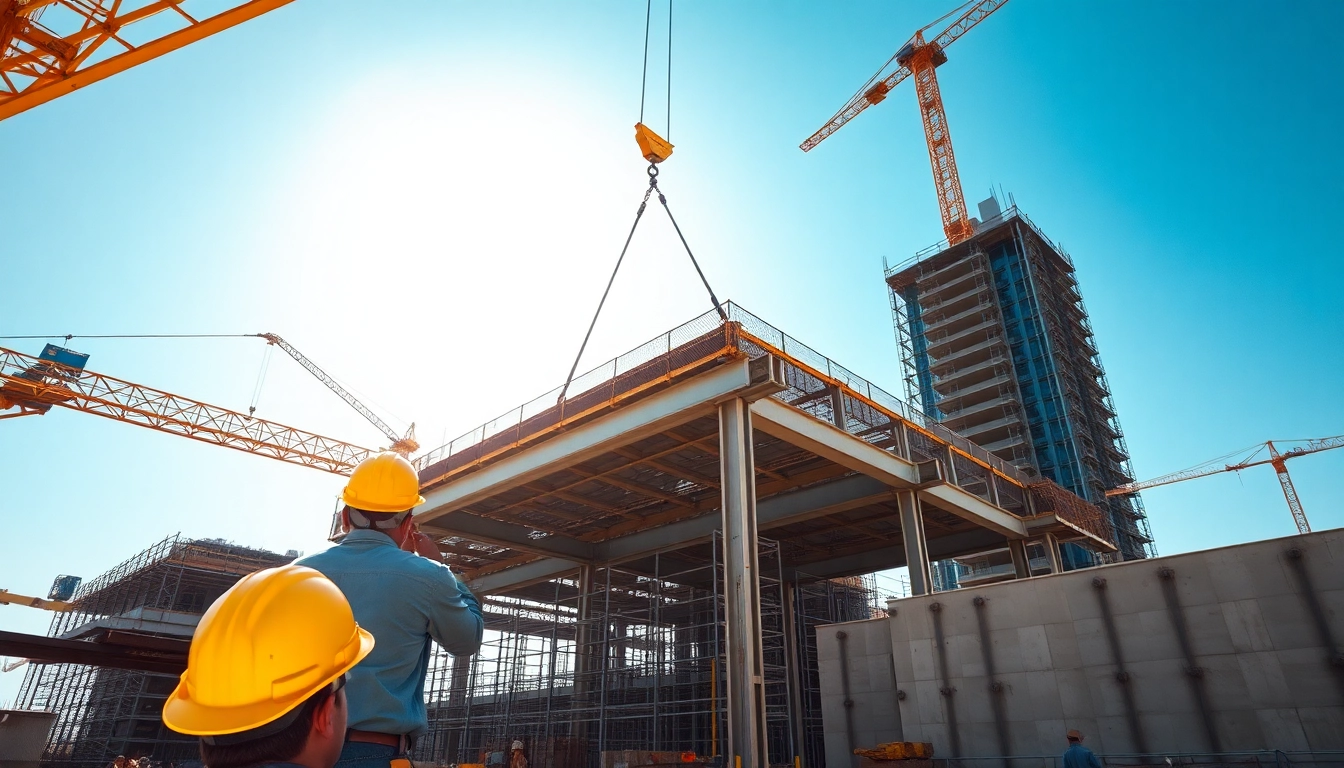Understanding Structural Steel Construction
Structural steel construction plays a pivotal role in the modern building industry. This technique utilizes steel as a primary material in creating robust and durable structures, providing architects and engineers with the flexibility to design various forms and functionalities. Whether it’s skyscrapers, bridges, or industrial buildings, the structural steel construction approach offers significant benefits in strength, cost-effectiveness, and design versatility. In this article, we will delve into the intricate details of structural steel construction, exploring its history, applications, advantages, types, processes, and future trends.
What is Structural Steel?
Structural steel is a category of steel used specifically for making construction materials with shapes that can bear loads. It is characterized by its high strength-to-weight ratio, making it an ideal material for constructing frameworks that must endure significant structural loads. Typically processed from iron ore, structural steel undergoes various treatments to enhance its physical and chemical properties.
Common forms of structural steel include beams, columns, girders, and plates. The manufacturing process involves melting iron and adding various elements to produce different grades of steel, tailored for diverse building requirements. Each grade has its unique properties, suited for specific applications within construction projects.
Historical Context of Structural Steel
The use of structural steel began in the late 19th century, marking a significant transformation in construction methods. The Industrial Revolution introduced new technologies that allowed for the mass production of steel, thus making it accessible for construction projects. One of the earliest landmarks built using structural steel was the Eiffel Tower in the 1880s, showcasing steel’s potential for crafting intricate and tall structures.
As construction technology progressed, so did the understanding and implementation of structural steel. The early 20th century saw the rise of steel-framed skyscrapers in cities like New York and Chicago, revolutionizing urban landscapes. These early adopters recognized the benefits of steel, particularly its high strength and durability against diverse environmental challenges.
Applications in Modern Construction
Today, structural steel is integral to various types of construction projects, including:
- High-rise buildings: Structural steel is extensively used in the construction of skyscrapers, where strength and stability are crucial due to high wind loads.
- Bridges: Steel’s flexibility and strength make it ideal for bridges, allowing for longer spans without compromising safety.
- Industrial buildings: In environments that require large open spaces, structural steel provides the necessary framework while minimizing structural support materials.
- Residential construction: Increasingly, structural steel is utilized in homes, providing durability and modern aesthetics.
Advantages of Structural Steel Construction
Strength and Durability
One of the primary advantages of structural steel is its exceptional strength and durability. Steel’s inherent properties allow structures to withstand a variety of stresses, including tension, compression, and shear forces. Moreover, when properly treated and maintained, structural steel exhibits excellent corrosion resistance, ensuring longevity in challenging environments.
Additionally, structural steel is non-combustible, providing enhanced fire resistance compared to wood or other materials. This characteristic makes it a popular choice not only for residential buildings but also for large buildings where fire safety regulations are stringent.
Cost-Effectiveness
While the initial cost of structural steel may be higher than other materials, the overall cost-effectiveness is evident throughout the construction process. Off-site fabrication allows for faster assembly on-site, reducing labor expenses and project timelines. Furthermore, the durability of structural steel translates to lower maintenance costs over time, making it an economically sound choice in the long run.
Design Flexibility
Structural steel offers unparalleled design flexibility, allowing architects to explore more intricate designs and larger open spaces without the limitations imposed by other building materials. It can be easily fabricated into various shapes and sizes, providing creative freedom while maintaining structural integrity. This adaptability is vital when constructing modern designs that require both aesthetic appeal and structural reliability.
Types of Structural Steel Used in Construction
Common Structural Steel Shapes
Various shapes of structural steel are employed in construction, each serving a specific purpose. Some of the most common include:
- I-beams: Also known as H-beams, these have a cross-section shaped like the letter “I,” providing excellent strength for spanning and supporting loads.
- Channel beams: Shaped like a “C,” these steel members are used for secondary support in construction.
- Angle sections: With an L-shaped cross-section, these are versatile and commonly used in framing.
- Plates and bars: Flat pieces of steel, used for various applications in building structures.
Material Grades and Their Uses
Steel is classified into different grades based on its chemical composition and mechanical properties. Common grades used in structural applications include:
- A36 steel: Mild steel suitable for various general construction applications.
- A992 steel: A high-strength steel used primarily in building frames.
- A572 steel: Known for its high strength and low weight, making it ideal for bridges and high-rise buildings.
Choosing the right grade is crucial for ensuring the structural integrity of a project and complying with safety regulations.
Innovative Steel Types and Alloys
Advancements in material science have led to the development of innovative steel types and alloys that enhance performance in specific applications. For instance, weathering steel, known for its corrosion resistance, is often used in bridges and exposed structures. Stainless steel is another innovative option that offers enhanced resistance to rust, providing longevity in harsh environments.
These innovations ensure that structural engineers and architects have access to materials that meet modern construction demands while addressing sustainability and resilience concerns.
The Structural Steel Construction Process
Pre-Construction Planning
The success of any structural steel construction project begins with meticulous planning. This phase involves assessing the project requirements, selecting appropriate materials, and employing the necessary engineering techniques. Engineers often utilize advanced software for structural analysis and design, ensuring adherence to safety regulations and building codes.
Collaboration with architects, designers, and contractors is essential during this phase to align goals and streamline processes. Detailed timelines and budgets are established, addressing potential challenges efficiently.
Assembly Techniques
The assembly of structural steel components is a specialized process that typically occurs on-site. Following the preparation of the site and foundation, various assembly techniques are employed, including:
- Bolting: The most common method for connecting steel components, providing a strong and flexible joint.
- Welding: Used when a permanent and rigid connection is required; however, it necessitates careful handling to avoid structural weaknesses.
- Pre-fabrication: Involves assembling elements off-site for quicker installation on-site, reducing weather-related delays.
Effective communication and coordination among the construction team are critical throughout the assembly phase to ensure safety and adherence to design specifications.
Safety Considerations on Site
Safety is paramount in structural steel construction. Given the heavy materials and elevated work conditions, rigorous safety regulations must be followed to prevent accidents. Essential safety measures include:
- Personal protective equipment (PPE): All workers must wear suitable PPE, including helmets, gloves, and harnesses.
- Site inspections: Regular safety audits and inspections should be conducted to identify and rectify potential hazards.
- Training programs: Workers should undergo training related to steel construction safety protocols, maintenance of equipment, and emergency response measures.
Future Trends in Structural Steel Construction
Sustainable Practices in Steel Use
As the construction industry moves towards sustainability, the use of recycled steel has gained momentum. Structural steel is one of the most recyclable materials in construction, with a life cycle that can be extended indefinitely through recycling. This has led to reduced waste in landfills and lower carbon emissions associated with production.
Moreover, improving the energy efficiency of production processes can further enhance the sustainability of structural steel. Investing in greener production technologies and materials is becoming a priority among construction firms aiming to minimize their environmental impact.
Technological Advancements in Fabrication
Technological innovation is paving the way for advancements in structural steel fabrication. Techniques such as 3D printing and automated fabrication are being explored to enhance precision and reduce waste in steel structures. Building Information Modeling (BIM) is also revolutionizing steel construction by allowing for detailed pre-construction visualization, improved collaboration among stakeholders, and responsive alterations to evolving project needs.
Global Market Trends and Projections
The global market for structural steel construction is expected to see steady growth, driven by urbanization, infrastructure development, and the demand for sustainable building materials. Emerging economies are investing heavily in infrastructure projects, necessitating the need for robust and durable construction materials, which bodes well for the structural steel market.
Additionally, increasing investments in research and development are likely to lead to more efficient production methods, making structural steel an even more attractive option for construction projects worldwide.



